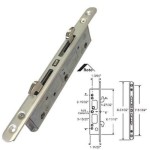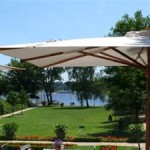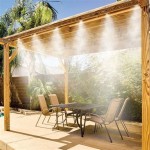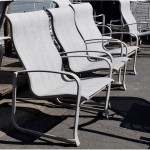Navy and White Patio Umbrellas: A Practical and Stylish Outdoor Shade Solution
Patio umbrellas are essential components of outdoor living spaces, providing shade and protection from the sun's harmful rays. A navy and white patio umbrella offers a classic and versatile color combination that complements a wide range of outdoor décor styles. The selection of a suitable patio umbrella necessitates careful consideration of various factors, from size and materials to features and functionality. This article explores the key aspects of navy and white patio umbrellas, providing detailed information to assist in making an informed purchasing decision.
Understanding the Benefits of Shade and UV Protection
The primary function of a patio umbrella is to provide shade, thereby reducing exposure to direct sunlight. Prolonged exposure to ultraviolet (UV) radiation from the sun can lead to sunburn, premature aging of the skin, and an increased risk of skin cancer. A quality patio umbrella, particularly one made with UV-resistant fabric, can significantly reduce the amount of UV radiation reaching the user, offering protection against these harmful effects. Darker colors, such as navy, generally offer better UV protection compared to lighter colors. While white reflects sunlight, it doesn't inherently block UV rays in the same way that a denser, darker fabric does. The combination of navy and white can provide a balance between solar heat absorption and UV protection, especially when high-quality, UV-treated fabrics are used.
Beyond UV protection, shade also contributes to thermal comfort. By blocking direct sunlight, patio umbrellas reduce the temperature of the shaded area, creating a more comfortable outdoor environment, especially during hot summer months. This can make outdoor spaces more enjoyable and encourage greater use of patios, decks, and other outdoor areas.
The choice of fabric is crucial to both UV protection and overall durability. Polyester fabrics treated with UV inhibitors are common and offer a good balance of protection and affordability. Acrylic fabrics, such as those branded as Sunbrella, are known for their superior UV resistance, colorfastness, and resistance to mildew and fading. While more expensive, acrylic fabrics offer a longer lifespan and sustained performance, making them a worthwhile investment for those seeking maximum protection and longevity.
Choosing the Right Size and Style
The size of the patio umbrella should be proportionate to the area it is intended to shade. A small umbrella may be suitable for a bistro table or a single lounge chair, while a larger umbrella is necessary to shade a dining table or a seating area. Patio umbrellas are typically measured by their diameter, with common sizes ranging from 6 feet to 13 feet or more. The appropriate size depends on the configuration of the outdoor space and the desired coverage area.
When selecting the umbrella size, consider the following guidelines:
- 6-7 foot umbrella: Suitable for small tables with 2-4 chairs.
- 8-9 foot umbrella: Ideal for dining tables with 4-6 chairs or a small seating area.
- 10-11 foot umbrella: Provides ample shade for larger dining tables with 6-8 chairs or a larger seating area.
- 12-13 foot umbrella or larger: Suitable for very large dining tables or extensive seating areas.
In addition to size, the style of the umbrella should also be considered. There are several types of patio umbrellas, including:
- Market umbrellas: The most common type, featuring a central pole and a round or octagonal canopy.
- Cantilever umbrellas: Also known as offset umbrellas, these have a pole that is offset to the side, allowing the canopy to be positioned over a larger area without the pole obstructing the seating area.
- Rectangular umbrellas: Designed to provide shade over rectangular tables or seating areas.
- Bistro umbrellas: Smaller umbrellas designed for small tables or balconies.
A navy and white striped market umbrella offers a classic and timeless aesthetic. Alternatively, a solid navy canopy with a white trim provides a more modern and understated look. The choice of style is a matter of personal preference and should complement the existing outdoor décor.
The frame materials also play a critical role in the umbrella's stability and durability. Aluminum frames are lightweight, rust-resistant, and relatively inexpensive. Steel frames are stronger and more durable but are also heavier and more susceptible to rust if not properly treated. Wood frames offer a classic and elegant look but require more maintenance to prevent rot and decay. The choice of frame material depends on the budget, the desired aesthetic, and the level of maintenance required.
Evaluating Features and Functionality
Several features can enhance the functionality and usability of a patio umbrella. These include:
- Tilt mechanism: Allows the canopy to be tilted to block sunlight from different angles as the sun moves across the sky. This is particularly useful in the late afternoon when the sun is lower in the horizon.
- Crank lift: A mechanism that makes it easy to raise and lower the canopy. Crank lifts are typically more durable and easier to use than pulley systems.
- Wind vent: An opening at the top of the canopy that allows wind to escape, reducing the risk of the umbrella being blown over in windy conditions. Double wind vents provide even greater wind resistance.
- Rib construction: The number and strength of the ribs that support the canopy affect the umbrella's stability and durability. More ribs and stronger materials generally provide greater wind resistance.
- Base: A sturdy base is essential to keep the umbrella from tipping over. Bases are typically made of concrete, steel, or resin and are filled with sand or water to add weight. The weight of the base should be appropriate for the size of the umbrella and the typical wind conditions in the area.
- Lighting: Some patio umbrellas feature integrated LED lights, providing illumination for evening use. These lights can be powered by batteries or solar panels.
When selecting a navy and white patio umbrella, it is important to consider the climate in which it will be used. In areas with strong winds, a heavier base, a wind vent, and a sturdy frame are essential. In areas with frequent rain, a water-resistant canopy and a rust-resistant frame are important considerations. The chosen features should align with the specific needs and environmental conditions of the intended use location.
The colorfastness of the fabric is another crucial factor. A high-quality fabric should resist fading even after prolonged exposure to sunlight. Acrylic fabrics are generally more colorfast than polyester fabrics. Look for fabrics that are specifically treated to resist fading and UV degradation.
Proper maintenance is essential to prolong the lifespan of a patio umbrella. Regularly clean the canopy with mild soap and water to remove dirt and debris. Store the umbrella in a dry place when not in use, especially during periods of inclement weather. Cover the umbrella with a protective cover to shield it from the elements and prevent fading and damage. Inspect the frame and hardware regularly and tighten any loose screws or bolts. With proper care and maintenance, a navy and white patio umbrella can provide years of reliable shade and enjoyment.

Mf Studio 10ft Patio Umbrella 3 Tier Vented Outdoor Market With Crank And Tilt All Aluminum Frame Navy Blue Walmart Com

Blue And White Striped Patio Umbrella Design Ideas

Navy Blue Patio Umbrellas At Lowes Com

Nina Navy White Trim Patio Umbrella

Yaheetech 2 7m Navy Blue Patio Parasol Umbrella W Push Button Tilt And Crank

Orion Navy Blue With Cream Piping Fabric Patio Umbrella Living Spaces

Justlet 6 5 X10 Navy Blue Patio Umbrella Rectangular Shade For Outdoor Spaces Jardin Deco Walmart Com

Navy Blue Outdoor Umbrella Over White And Pool Loungers Transitional

Ovastlkuy 7 Ft Outdoor Market Patio Umbrella In Navy Blue With Push Button Tilt And Tassel Design U00t0048 Nb The Home

The Market Umbrella Rivie White Business Pleasure Co
See Also








